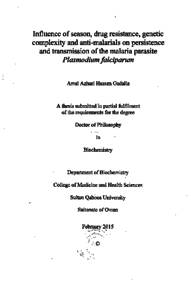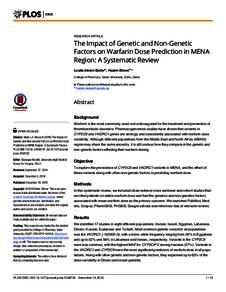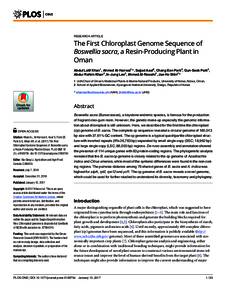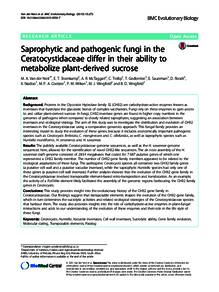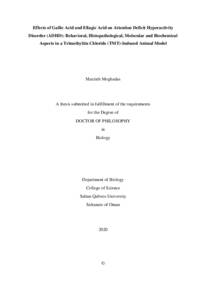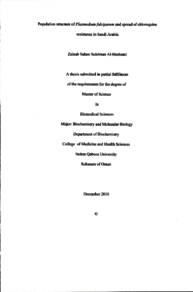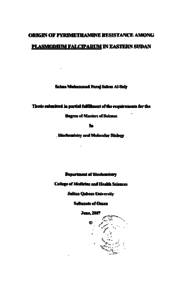Document
Influence of season, drug resistance, genetic complexity and anti-malarials on persistence and transmission of the malaria parasite : Plasmodium falciparum
Publisher
Sultan Qaboos University
Gregorian
2015
Language
English
Subject
English abstract
Following marked reduction in malaria cases and deaths in the recent years, policies and research interests have now shifted toward elimination and eradication of the disease by 2050. Among the various challenges that face the prospect of malaria elimination/ eradication is the frequent carriage of the parasite as asymptomatic infection at levels not detectable by conventional methods. Thus asymptomatic parasitaemia is a hidden source of infection with great transmission potential. This thesis examined some biological characteristics of asymptomatic parasitaemia and factors affecting their transmission potential (gametocyte production) in seasonal transmission areas. The present work investigated the infection parameters; parasite and gametocyte densities, multiplicity of infection and carriage of drug resistance genotypes among a cohort of 36 asymptomatic carriers, who were initially enrolled with microscopic confirmed P. falciparum during the transmission season, treated and then followed up monthly for 12 consecutive months, including 9 months of transmission-free and absence of therapy. The impact of season, parasite density and within host multiplicity of infection on gametocyte density was evaluated using generalized linear mixed model that consider longitudinal design and allows for extreme variability in gametocyte density between the transmission and the dry season. In addition, the relative abundance of wild-type compared to the mutant genotype of drug resistance genes and its association with gametocytes was examined. Also, the effect of therapy on gametocytogenesis was studied on a cohort of uncomplicated malaria (n=106) treated with chloroquine (CD) or sulfadoxinel pyrimethamine (SP) and then examined on weekly bases; day 0, 7, 14 and 21. qPCR of 18S rRNA was used to quantify parasite density, while gametocyte stage specific genes qRT-PCR assays were used to quantify early (pfgel) and late (pfs25 and pfs230p) gametocytes stages. qPCR allelic discrimination was used to identify alleles of drug resistance genes pfort and pfmdr-1, and qPCR relative quantification was used to estimate relative density of sensitive compared to resistant alleles. Multiplicity of infection was estimated by genotyping of two polymorphic genes pfg377 and msp-2. Among the asymptomatic cohort, low levels of P. falciparum parasitaemia (monthly average < 50 parasites/ul) and gametocytaemia (monthly average of 2-20 gametocytes/ul) persisted for up to 9 months in absence of new infection, during the dry and transmission-free season. However, both gametocyte density and gametocyte parasite ratio increased significantly following the start of annual rains (surrogate for mosquitoes abundance), prior to the appearance of clinical malaria, demonstrating an impact of season on transmission of asymptomatic parasitaemia. Gametocyte production was associated with infections with multiplicity 2 parasites clones). Relative wild-genotype densities of both pfcrt 72-76 and pfmdr-1 86 showed a progressive increase among asymptomatic carriers in absence of therapy during the dry season. Following treatment of uncomplicated P. falciparum malaria with CQ or SP, there was an increase in early gametocyte/parasite ratio on day14 post-treatment among infections with adequate parasitological response despite a > 90% reduction in parasitaemia on D7 indicating enhanced gametocytogenesis following drug
administration. In addition, late gametocyte peaked on day 7 and 14 following treatment suggesting release of sequestrated early gametocytes.
The present results provided clear evidence for season as independent modulator of gametocyte density among asymptomatic P. falciparum carriers, supporting the hypothesis that malaria parasites might enhance gametocytogenesis when the opportunity of transmission occurs. In addition, it quantitatively proved the hypothesis of fitness cost of drug resistance mutations in absence of therapy. The present results also provided some answers to questions regarding the effect of anti malarial drugs on gametocytogenesis. These information are of significant implications for malaria treatment, control and elimination, particularly in seasonal transmission areas
Description
Thesis
Member of
Resource URL
Arabic abstract
يسبب طفيل المنصورة المنجلية مرض الملاريا المنجلية و ينتقل إلى الإنسان عن طريق الباعوض حيث يهاجم كريات الدم الحمراء و يسبب الحمى، فقر الدم وتضخم الطحال. ينتشر هذا المرض في المناطق ذات المناخ الإستوائي وشبه الإستوائي، وينتقل بعد هطول الأمطار في المناطق ذات الإنتشار الموسمي. إتجهت الجهود العلمية و الرسمية لإستأصال المرض نتيجة للإنخفاض الملحوظ في حالات مرض الملاريا في السنوات الأخيرة. إلا أن وجود الطفيل بأعداد قليلة جدا يصعب اكتشافها بالمجهر الضوئي لدى الأشخاص المصابين بالطفيل و لكن لا تظهر عليهم الأعراض يعوق تحقيق أهداف الإستأصال. تهدف هذه الرساله إلى تحديد أثر بعض العوامل البيئية و الجينية على انتشار طفيل الملاريا من حاملي الطفيل غير المرضى في المناطق ذات الإنتشار الموسمي للمرض. شملت هذه الدراسة 123 مريضة بالملاريا في نوفمبر 2001, تم تشخيص 36 فردا منهم كحاملين للطفيل غير المرضى خلال المتابعة الشهرية والتي استمرت لمدة 13 شهرة إبتداءا من موسم إنتشار العدوي (نوفمبر 2001) و خلال فترة الجفاف الخالية من الباعوض الناقل للطفيل يناير الى يوليو 2002) و بداية فترة الأمطار (أغسطس و سبتمبر 2002) إلى موسم الانتشار القادم (أكتوبر و نوفمبر 2002). تم تشخيص كثافة الطفيل ككل وكثافة الطور المسئول عن نقل الطفيل إلي البعوض، لدى حاملي الطفيل غير المرضى. كما تم تحديد التنوع الجيني للطفيل في نفس العدوى و الجينات المرتبطة بمقاومة الطفيل للأدوية. لدراسة كيفية تأثير أدوية الملاريا على مراحل تطور الطور المعدي للباعوض، تم استخدام عينة من مرضى الملاريا الذين ولجواب chloroquine أو sulfadoxine / pyrimethamine و متابعتهم في اليوم السابع و الرابع عشر و الحادي و العشرين بعد العلاج. كما تم حساب أعداد الطفيل و مراحل الطور المعدي ثم مقارنتها ما بين المرضي الذين استجابوا للعلاج بنقصان أعداد الطفيل و المرضى الذين لم يستجيبوا للعلاج. خلصت الدراسة إلي وجود زيادة مثبته إحصائيا في أعداد الطور المعدي للبعوض لدي حاملي الطفيل غير المرض منطقة الدراسة. كما وجدت الدراسة أن أعداد الطور المعدي للباعوض تزيد لدي حاملي طفيليات ملاريا متنوعة جينية. أثبتت الدراسة زيادة أعداد الطفيل ذي الجينات المتعلقة بمقاومة الطفيل للأدوية غير المتحولة خلال فترة الجفاف، والتي تتميز بمحدودية إستخدام أدوية الملاريا. أوضحت الدراسة زيادة في أعداد الطور المعدي للبعوض في المراحل الأولية من التطور في اليوم الرابع عشر بعد العلاج لدى المرضى الذين استجابوا و الذين لم يستجيبوا للعلاج. كما أظهرت النتائج زيادة في أعداد الطور المعدي للبعوض في مراحل النمو المتأخرة, في اليوم السابع و الرابع عشر أيضا لدى المرضى الذين استجابوا و الذين لم يستجيبوا للعلاج على حد منطقة ست المرضى عند بداية موسم الأمطار اعداد الطور المعدي للباعوض و قبل موسم انتتشار حالات الملاريا السريرية في سواء. أوضحت الدراسة أهمية انتشار العدوى من حاملي الطفيل غير المرضى و إمكانية نقل الطفيل إلى المناطق الخالية من حالات الملاريا. كما خلصت الي أن مكافحة الملاريا في المناطق ذات الإنتشار الموسمي بإعتماد الأدوية أو اللقاحات القاتلة للطور المعدي للبعوض يجب أن تتم عند بداية الأمطار الموسمية، مع تجنب استعمال الأدوية التي تحفز إنتاج الطور المعدي للبعوض في هذه الفترة. كما أشارت النتائج أهمية عدم استعمال عقاقير الملاريا في فترة الجفاف.
Category
Theses and Dissertations

